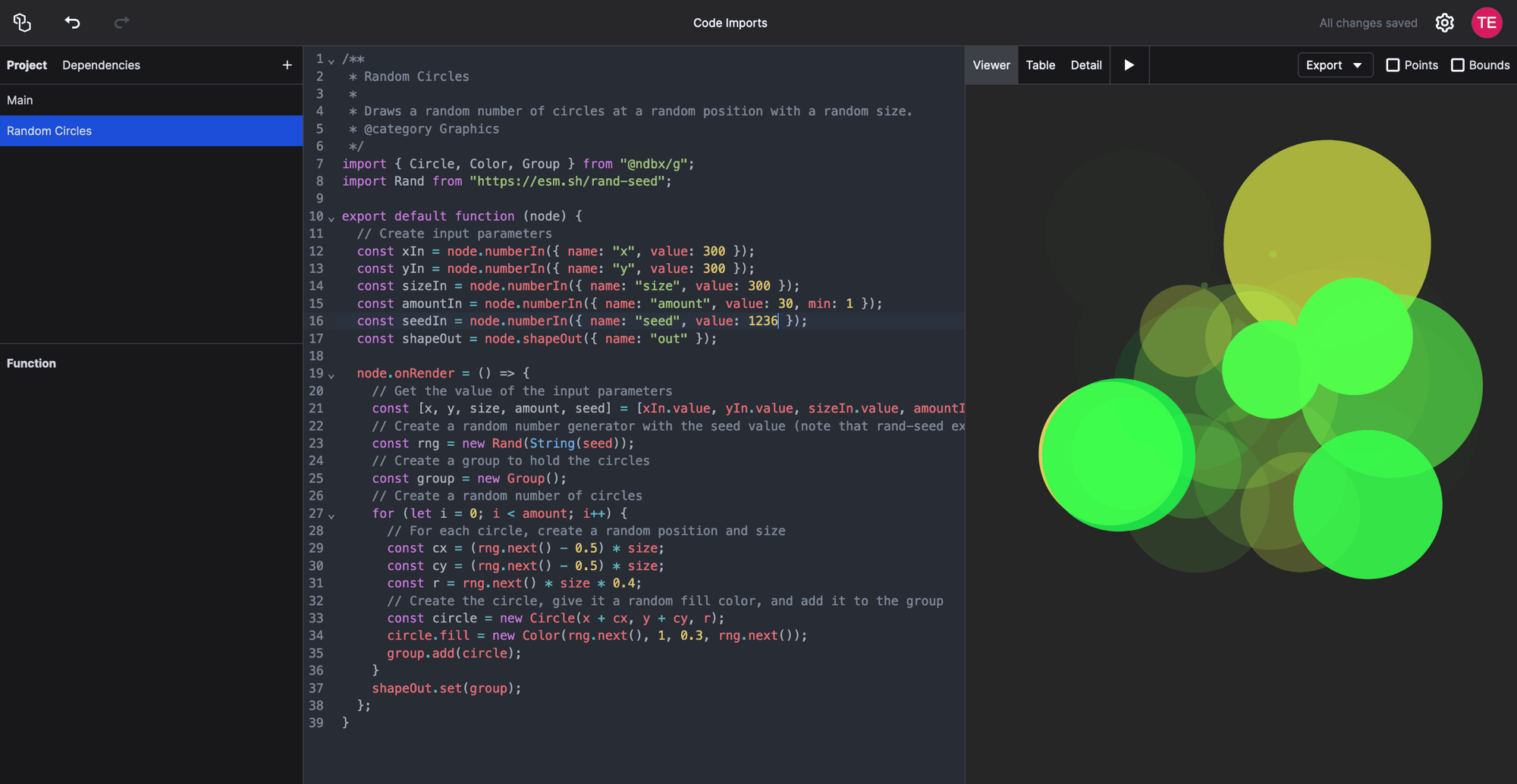When coding, you can use existing JavaScript libraries to extend the functionality of NodeBox. You've already seen how you can use NodeBox's @ndbx/g library, but you can almost all available libraries on npm. To import, we prefer using esm.sh, a modern CDN that allows you to import es6 modules from a URL. (You can also use Skypack or jspm.)
Tutorial: controllable random numbers
In generative design we often use random numbers. The issue with random numbers is that they're not controllable: every time you render the composition, you will get a different result, with no way to store or reproduce a given variation.
If you want to be able to use random numbers while still being able to "hold on" to a certain variation, you can use a library that generates random numbers based on a seed value: a fixed value that determines the sequence of random numbers generated by the library. If you use the same seed value, you will get the same sequence of random numbers every time you run the composition. What's more, somebody else can use the same seed value and get the same sequence of random numbers as you did.
In this tutorial, we'll use the rand-seed library to create a small composition with circles. We'll use the @ndbx/g library to create the circles and the rand-seed library to generate random numbers:

Create a new function item in the outliner and name it "Random Circles". Add the following code:
/**
* Random Circles
*
* Draws a random number of circles at a random position with a random size.
* @category Graphics
*/
import { Circle, Paint, Group } from "@ndbx/g";
import Rand from "https://esm.sh/rand-seed";
export default function (node) {
// Create input parameters
const xIn = node.numberIn({ name: "x", value: 300 });
const yIn = node.numberIn({ name: "y", value: 300 });
const sizeIn = node.numberIn({ name: "size", value: 300 });
const amountIn = node.numberIn({ name: "amount", value: 30, min: 1 });
const seedIn = node.numberIn({ name: "seed", value: 42 });
const shapeOut = node.shapeOut({ name: "out" });
node.onRender = () => {
// Get the value of the input parameters
const [x, y, size, amount, seed] = [xIn.value, yIn.value, sizeIn.value, amountIn.value, seedIn.value];
// Create a random number generator with the seed value (note that rand-seed expects a string)
const rng = new Rand(String(seed));
// Create a group to hold the circles
const group = new Group();
// Create a random number of circles
for (let i = 0; i < amount; i++) {
// For each circle, create a random position and size
const cx = (rng.next() - 0.5) * size;
const cy = (rng.next() - 0.5) * size;
const r = rng.next() * size * 0.4;
// Create the circle, give it a random fill, and add it to the group
const circle = new Circle(x + cx, y + cy, r);
circle.fill = Paint.solid(rng.next(), 1, 0.3, rng.next());
group.add(circle);
}
shapeOut.set(group);
};
}
Note that we're importing the rand-seed library from a URL. This is possible because the library is available on npm and can be imported as an es6 module.
Once the project is saved, reload the window, then go to the Main network and add the Random Circles node. You can now control the number of circles, their size, and their position, and you can generate different variations by changing the seed value.
Library Versions
When using external libraries, it's important to note that the version of the library you're using may change over time. If you want to ensure that your project remains consistent, you can specify the version of the library you want to use in the import statement. For example:
import Rand from "https://esm.sh/[email protected]";
To know the version, type the URL without version number in the browser. ESM will redirect you to the latest version. You can then copy the URL with the version number.